Amazing archive photos show kitchens through history
The heart of the home captured in historic photographs
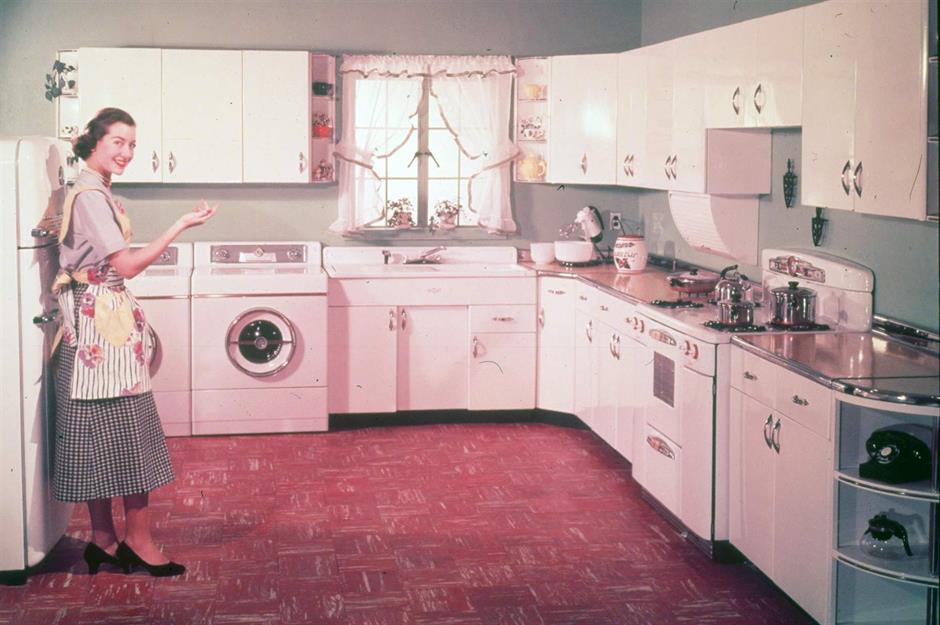
Step back in time for tea as we explore how kitchens have evolved over the past 150 years.
From makeshift hearths and tenement workspaces to mid-century efficiency and design-led interiors, these historic photographs reveal the changing role, technology, and style of domestic kitchens around the world.
Click or scroll to see how kitchen life transformed across time, class and culture...
1865: feeding Union troops at Soldiers’ Rest
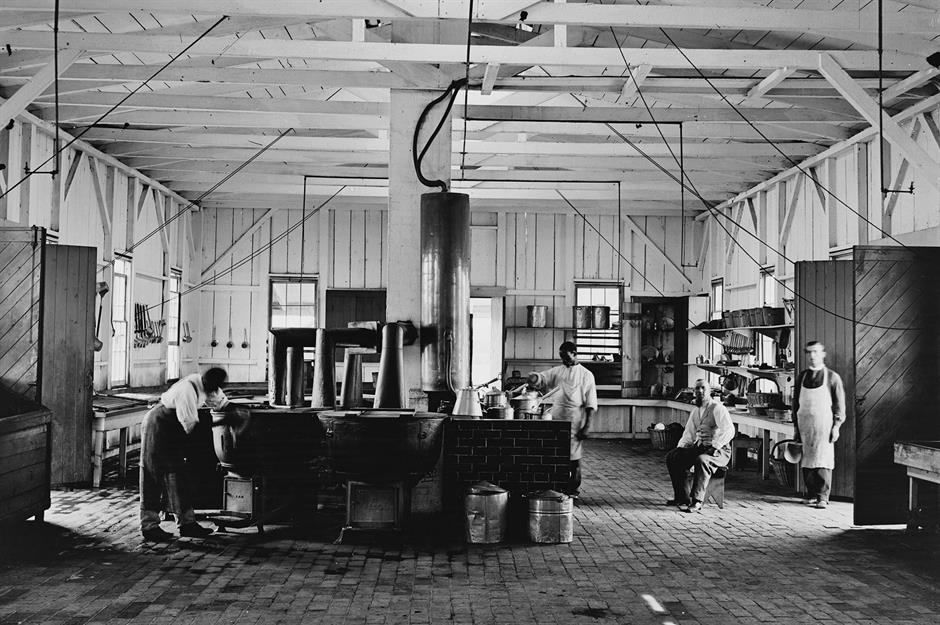
This Civil War-era photo was taken in Alexandria, Virginia, at a Union Army site known as Soldiers’ Rest. The makeshift kitchen served soldiers en route to and from the front, offering simple, hearty meals.
Outdoor cooking was common, using cast-iron kettles and Dutch ovens over open fires or trench stoves. Food was basic: hardtack, salt pork and stews, prepared in bulk with few utensils. Though the setting looks informal, such kitchens were crucial to keeping regiments nourished and ready for battle.
1880 to 1890: preparing dinner in a Meiji-era kitchen
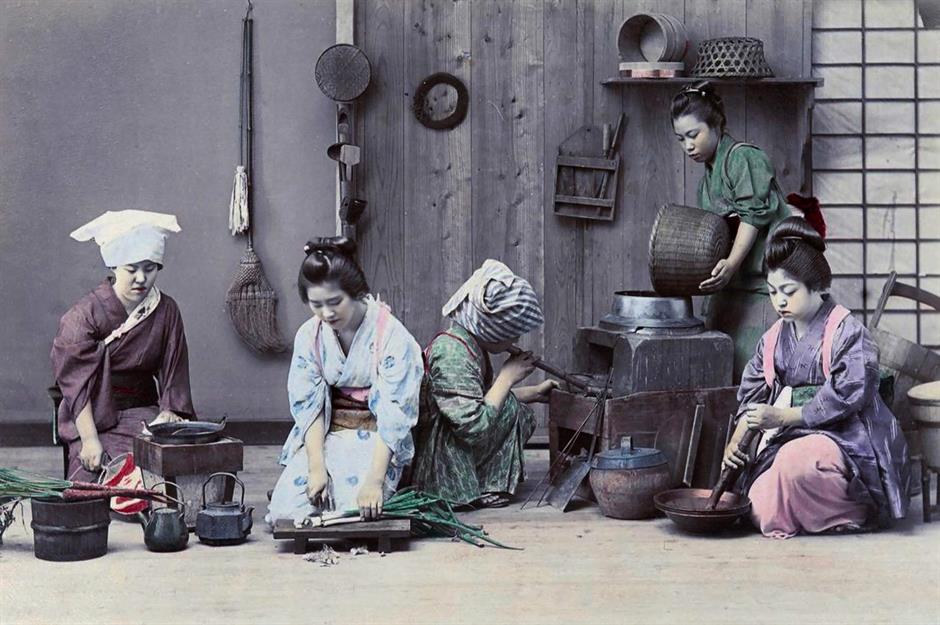
This hand-tinted image shows female kitchen workers preparing a meal in Japan during the Meiji period (1868–1912), a time of rapid modernisation.
Traditional Japanese kitchens, or kamado, were typically equipped with clay or brick stoves fuelled by wood or charcoal. Pots were suspended over the flame, and meals centred on rice, fish and seasonal vegetables.
Despite the western influences shaping society, domestic kitchens like this one remained rooted in centuries-old methods
1880 to 1890: domestic kitchen in a Dutch home
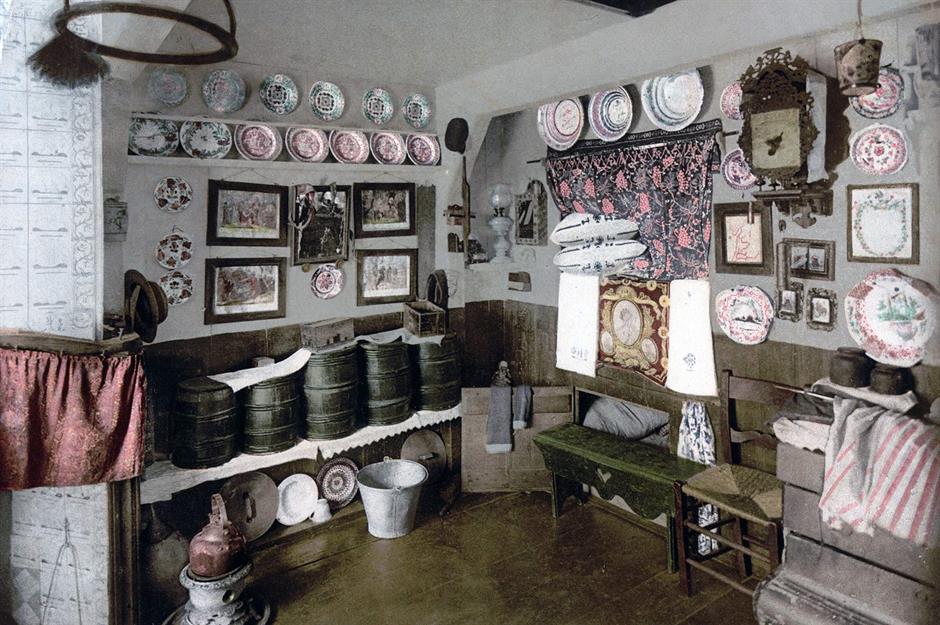
This late‑19th‑century kitchen, photographed in the Netherlands between 1890 and 1900, reveals the heart of daily domestic life in a traditional Dutch household.
The room features sturdy wooden shelving for Delftware plates and mugs, as well as iron cauldrons likely used for stewing and boiling over a brick or clay-lined hearth.
During this period, cast‑iron stoves were rare in modest homes, so cooking often involved an open fire or simple wood‑ or coal‑fired stoves.
1895: hearth and clayware in a Mexican kitchen
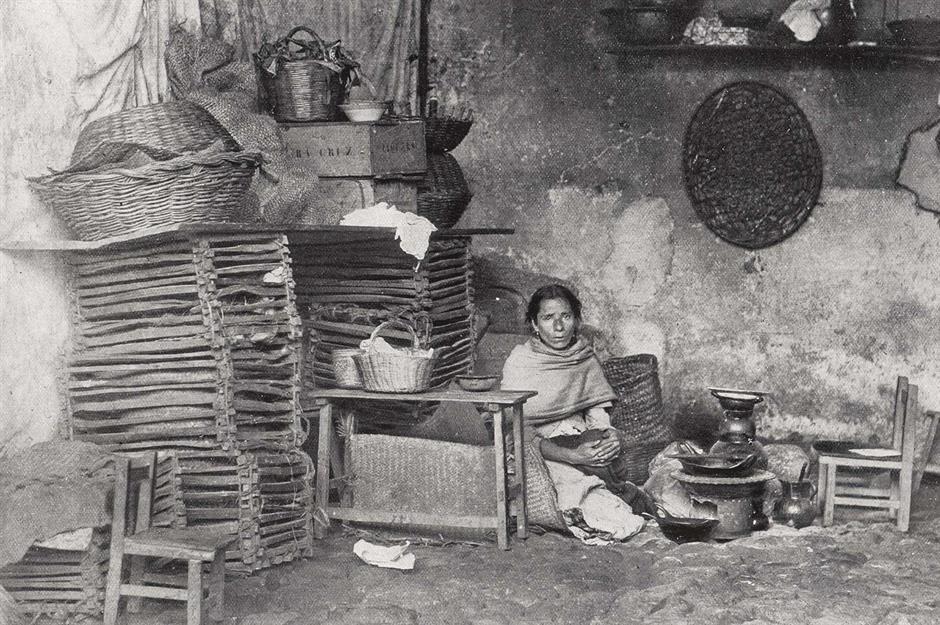
Photographed in Orizaba, Mexico, this 1895 halftone print captures a domestic kitchen still rooted in Indigenous and colonial-era traditions.
At its centre is a raised clay or stone comal used for making tortillas over an open fire, with large ceramic jars and earthenware pots nearby for storing water and preparing stews.
Walls were often whitewashed to reflect light and maintain hygiene. Despite the rural setting, the setup was practical and efficient, with cooking based around maize, beans and chillies, which were core ingredients of the Mexican diet for centuries.
1891: cooking for the president at the White House
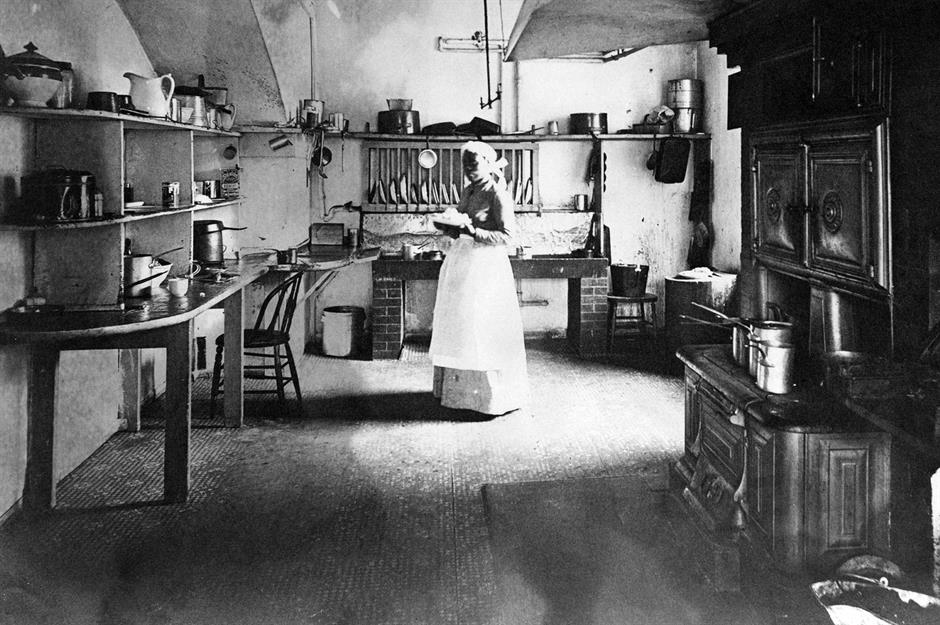
This rare photograph shows Dolly Johnson, cook to President Benjamin Harrison, working in the White House kitchen during the early 1890s. Located on the building’s ground floor, the kitchen was dark, poorly ventilated and prone to damp.
Meals were prepared using coal-fired cast-iron ranges, with large copper pans and iron cookware.
Staff lived on site in similarly cramped conditions. Though modest by today’s standards, this kitchen supported elaborate dinners for Washington’s elite and laid the groundwork for the more modern White House kitchens to come.
1900: colonial-style hearth in a New England home

Photographed around 1900, this image shows the kitchen of the Hancock-Clarke House in Lexington, Massachusetts. It was originally built as a parsonage for the grandfather of the founding patriot John Hancock, who stayed there on the eve of the Revolutionary War in 1775.
The colonial-style kitchen features a wide open hearth with iron cranes for suspending pots over a wood fire. Brick ovens built into the chimney wall were used for baking.
Crockery, barrels and utensils were stored in plain sight, reflecting the kitchen’s central role in daily life.
1900: toast-making on a Hoosier cabinet
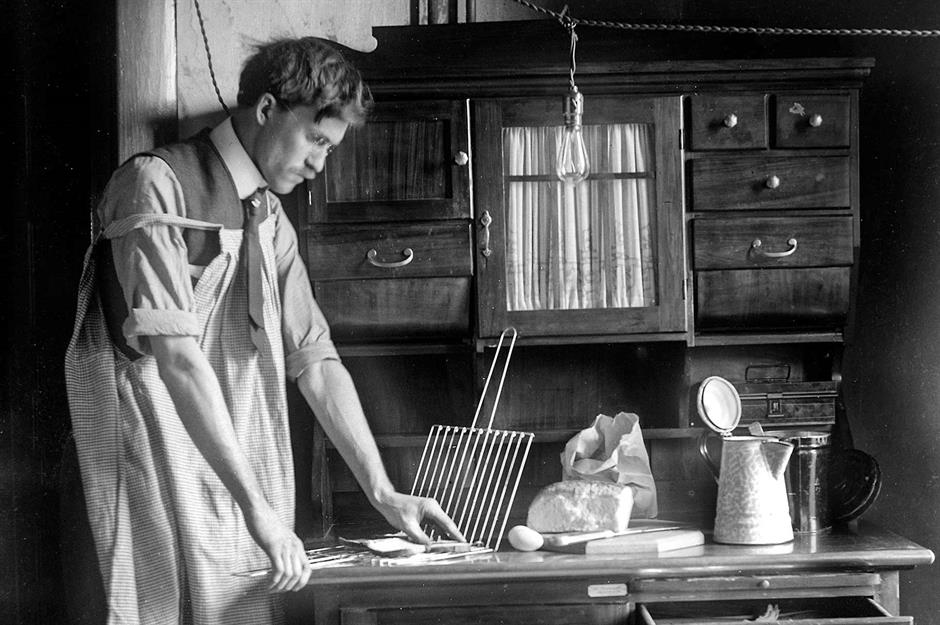
Around 1900, this photograph captures a man preparing toast on a Hoosier cabinet; a freestanding kitchen workstation popular before fitted cabinetry became standard.
Made of oak or wood, these early examples of multifunctional furniture featured pull‑out work surfaces, tin‑lined bread drawers and built‑in sifters.
They offered a compact hub for food prep, storage and baking tools, ideal for efficient meal routines in early 20th‑century kitchens. Bread was toasted in these metal frames or on a long fork, but the invention of the electric toaster was less than a decade away.
1904: women at work in a Malmö kitchen
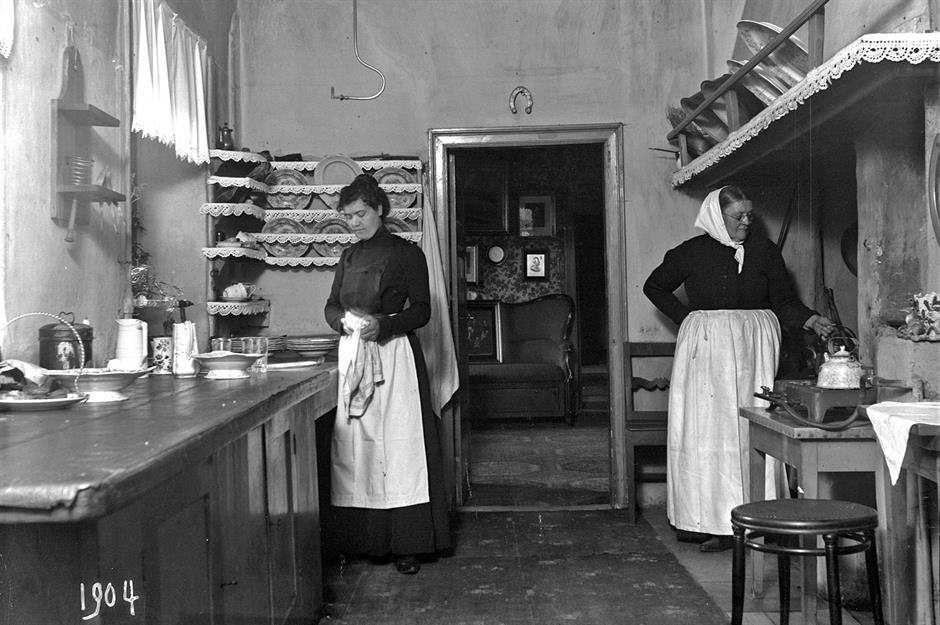
This black‑and‑white photograph taken in Malmö, Sweden, shows two women - quite likely cooks or servants - preparing food in a modest domestic kitchen (kök).
The space features unadorned walls, open shelving for utensils and crockery, and a window for natural light. Heating and cooking were likely fuelled by a wood or coal stove, allowing preparation of soups, porridge or simple stews.
The layout reflects functional efficiency, with room to store ingredients, wash dishes and manage daily meals in one central domestic hub.
1905: the birth of modernism
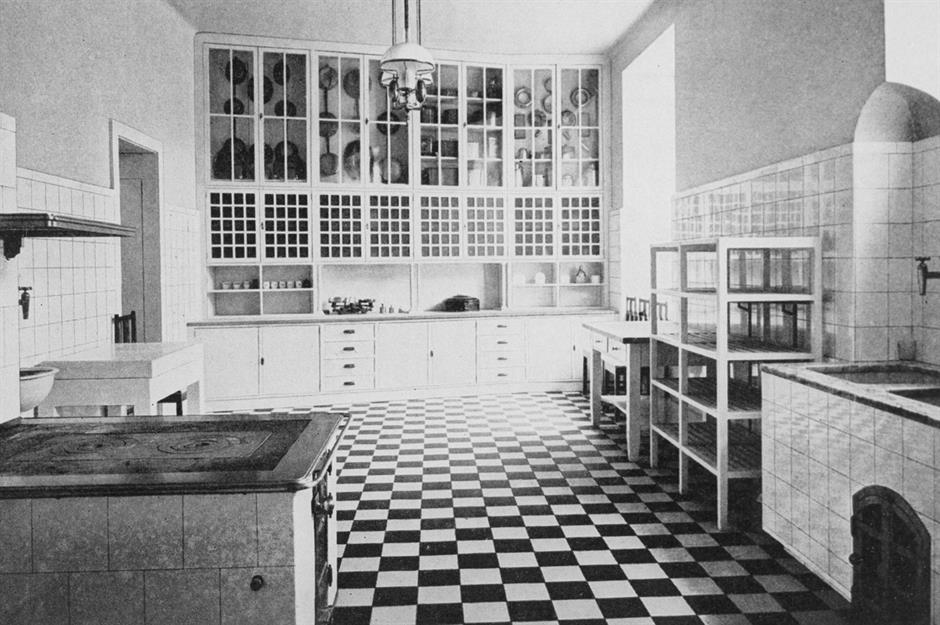
Designed in 1905 by Austrian architect Leopold Bauer, this kitchen reflects early 20th-century priorities of order, cleanliness and function. Bauer, known for blending traditional forms with modernist ideals, created spaces that were practical yet visually refined.
The smooth surfaces, tiled walls and built-in storage suggest an emphasis on hygiene and workflow, anticipating later developments in fitted kitchen design.
As architecture evolved to value efficiency across the home, kitchens like this marked a shift toward more considered, purposeful domestic planning in Central Europe.
1920: mod cons in a domestic kitchen
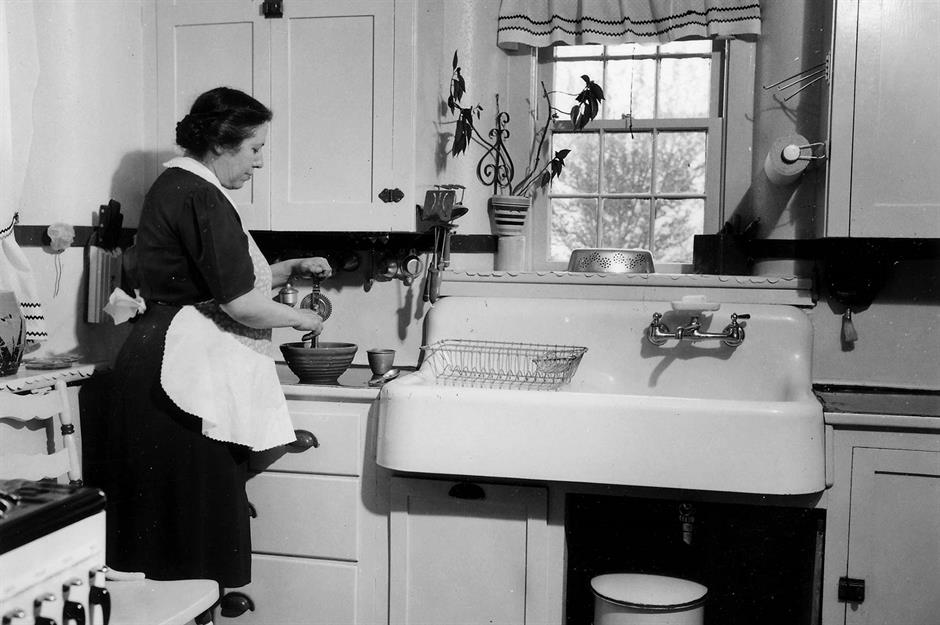
This 1920 image shows a woman using a manual hand-cranked mixer, a labour-saving innovation of the time. While electric kitchen appliances were still rare in most homes, mechanical tools like this made food preparation quicker and easier.
The kitchen features a classic Belfast sink with a drying rack mounted above it for draining pots and plates, along with a floral curtain adding a decorative touch to the window.
These details reflect the growing attention to practicality and comfort in early 20th-century domestic spaces.
1937: a maid at work in a service kitchen
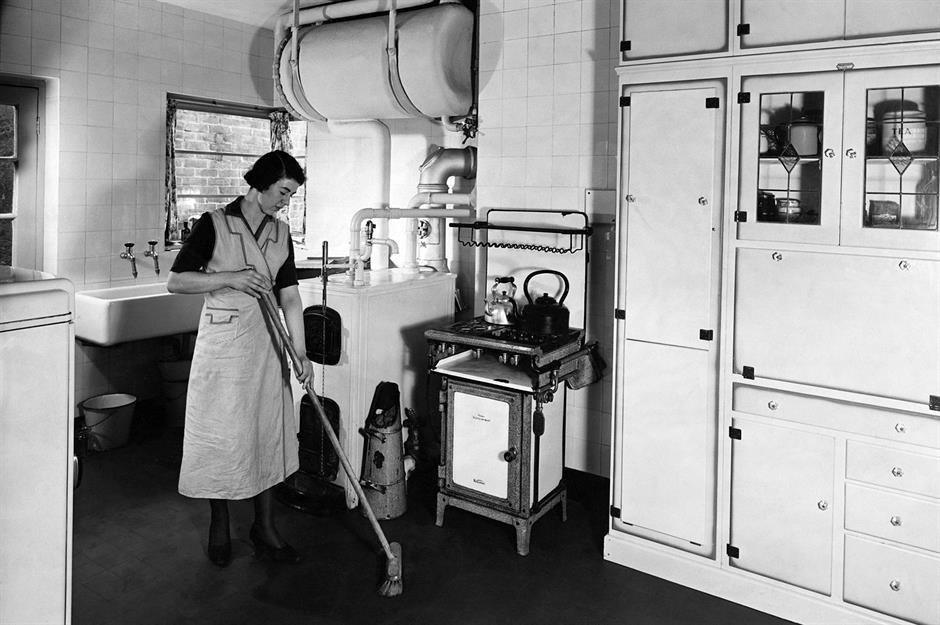
Photographed in 1937, this kitchen reflects the practical, service-oriented design typical of middle- and upper-class British homes in the interwar years.
The housemaid, dressed in uniform, is shown sweeping the tiled floor beside a compact cast-iron range used for boiling and roasting. Storage cupboards with glass panels held dry goods, while an overhead hot water tank fed the sink area.
Unlike modern open-plan kitchens, these were strictly workspaces to be kept orderly, functional and separate from dining or social areas.
1950: the modern American kitchen dream
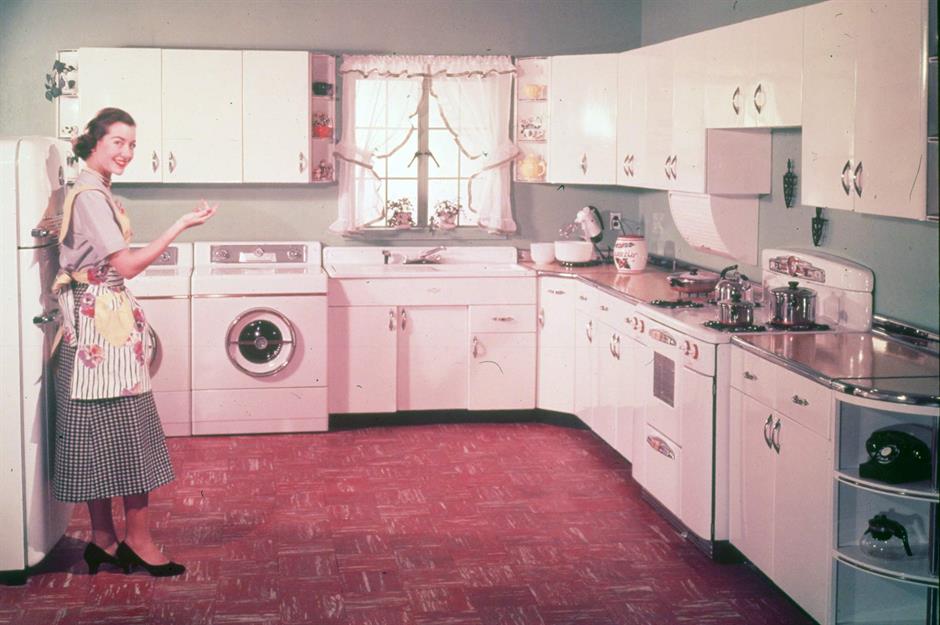
This staged photograph from the 1950s showcases a model in a quintessential post-war American kitchen. Fitted units in matching enamelled steel, a built-in oven, and worktops with integrated sinks reflect the era's drive toward efficiency and cleanliness.
Labour-saving appliances, like the washing machine and stand mixer, highlight the growing emphasis on convenience and the ideal of the ‘modern housewife’.
The red tile-effect flooring and pastel walls complete the cheerful, functional look promoted in design magazines and appliance adverts throughout the decade.
1955: family life in a postwar British kitchen
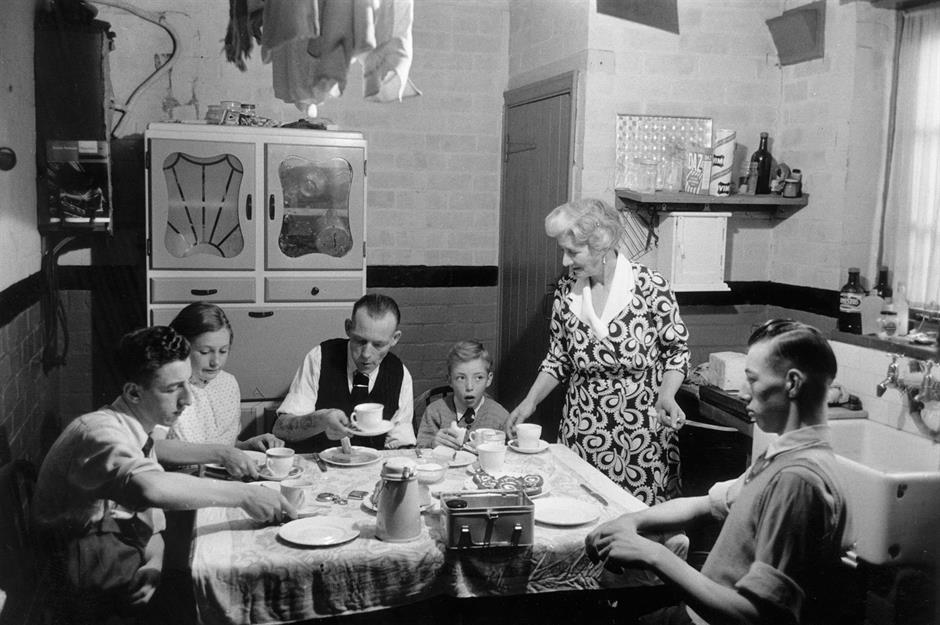
Taken in November 1955, this image of the Archer family captures everyday life in a modest British kitchen during a time of national recovery.
Postwar housing shortages meant many families lived in small terraced homes or council properties with multipurpose kitchens. This space includes a deep ceramic sink, a wall-mounted airer for drying clothes and a larder cabinet for dry goods.
Meals were shared at the kitchen table, reinforcing its role as the heart of the household in a space shaped by necessity and routine.
1974: Margaret Thatcher washes up during her campaign

In October 1974, the future British Prime Minister Margaret Thatcher, then Conservative education secretary and MP for Finchley, is captured washing dishes in a domestic kitchen setting as part of her general election campaign.
She was keen to present herself as a home‑minded politician who was comfortable with some traditional gender roles, designed to appeal particularly to the growing electorate of housewives.
The kitchen reflects a typical 1970s style: floral wallpaper, laminate worktops and a two-ring cooker were common in UK homes at that time.
1915: cooking in a converted boxcar home
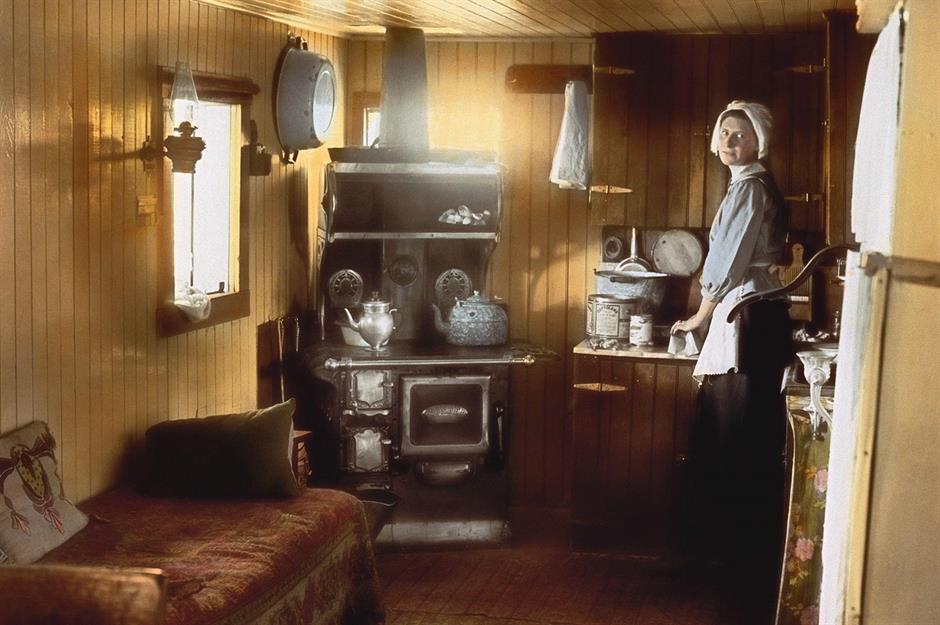
This colourised image from 1915 shows a woman working in the kitchen of her home, set up inside an abandoned railway boxcar in the American West.
These improvised dwellings were used by settlers and workers seeking affordable shelter during periods of expansion and hardship. The small kitchen includes a cast-iron stove used for both heating and cooking, with kettles and a coffee pot warming on top.
Limited worktop space, open shelves and tin containers reflect a practical, pared-back setup shaped by resilience and resourcefulness.
1960: bold colours brighten the swinging kitchen
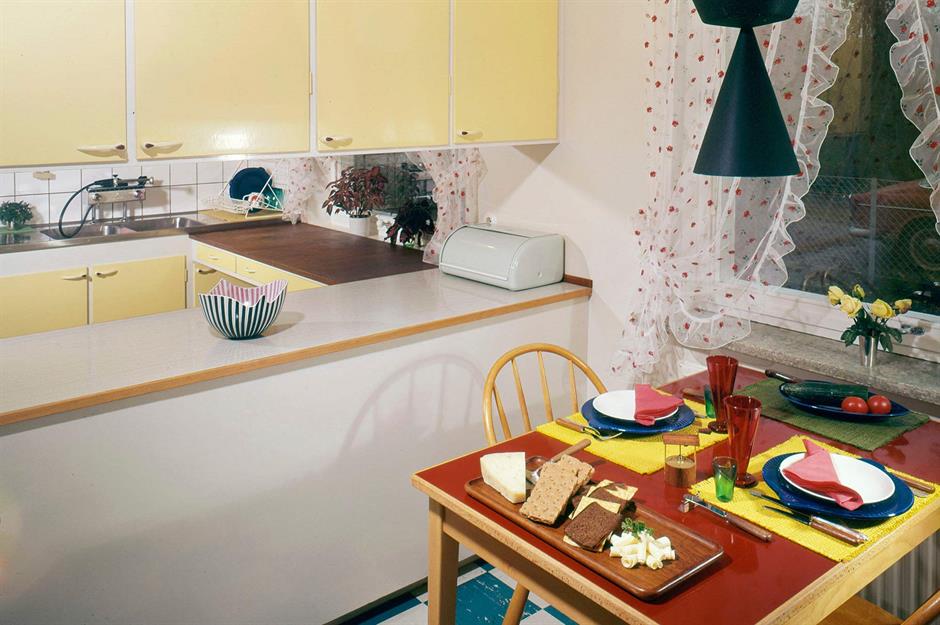
By the early 1960s, kitchens were catching up with the spirit of the decade. Gone were the muted tones of the postwar years; bold colours, sleek shapes and space-saving furniture were now in fashion.
This cheerful setup features bright yellow doors and a shiny red tabletop, capturing the playful optimism of the era. Kitchens were no longer just workspaces but social hubs too, with mealtimes becoming more casual.
1975: earthy tones take centre stage
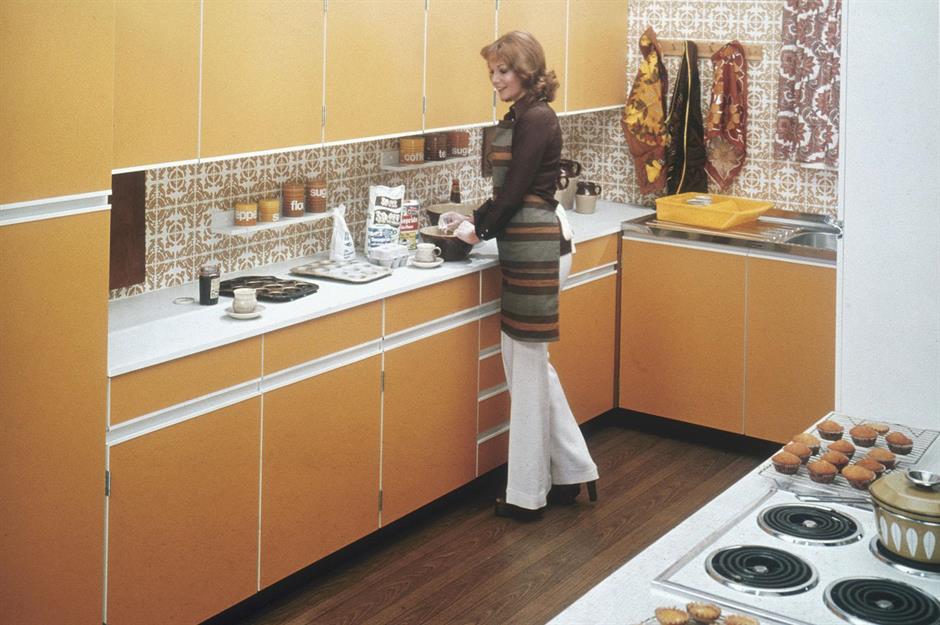
As the vibrant energy of the 1960s transitioned into the 1970s, home interiors began embracing a warmer, earthier palette.
Kitchens, once dominated by bold primaries and bright pastels, saw a shift toward combinations like burnt orange, avocado green and rich brown. These colours were often paired with natural textures such as wood veneer, cork, and rattan to create a cosy, grounded feel.
By 1975, the modern kitchen blended playful retro shades with practical design, reflecting a desire for both self-expression and homely comfort.
1911: nut picking in a tenement kitchen

This striking image shows Mrs Mary Caperale and her daughters picking nuts in the cramped kitchen of their tenement apartment at 141 Hudson Street, New York.
Like many immigrant families at the time, they took in ‘piecework’ to supplement their income and would have earned around $3 and $3.50 per week – about $98 (£74) and $114 (£85) in today’s money.
The kitchen is cluttered with kindling, waste and open bags of nuts, reflecting the overcrowding and lack of hygiene common in tenement housing. Despite long hours and poor pay, such labour was essential for survival in early 20th-century urban America.
1936: a refined farmhouse kitchen in interwar London
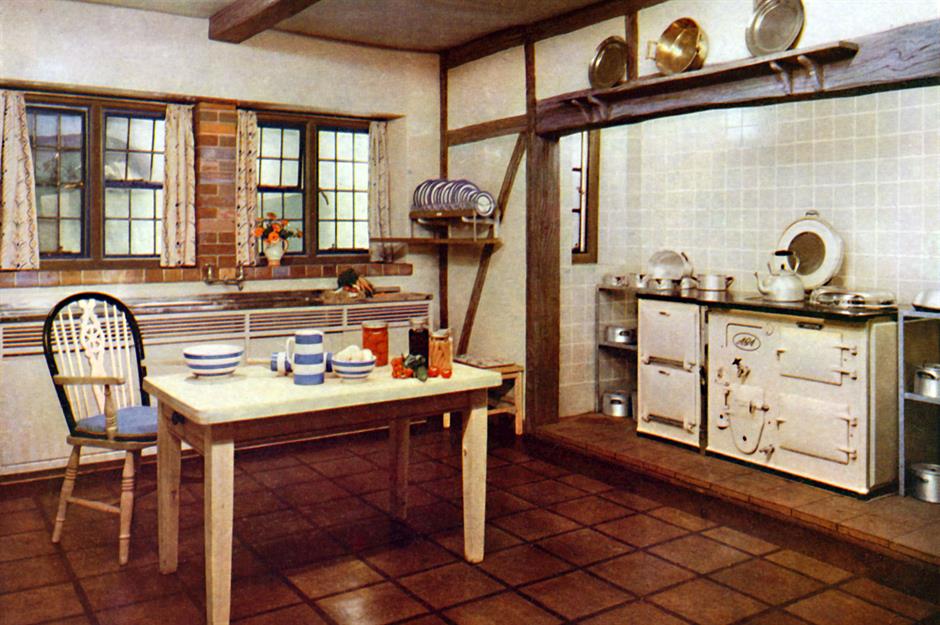
This carefully styled kitchen, redesigned by British interior decorator Mrs Darcy Braddell, blends traditional country charm with modern functionality.
Glazed tiles and stripped oak joinery add warmth and texture, while terracotta tiles underfoot reflect practical, hardwearing choices. The focal point is a coke-burning Aga cooker with a vitreous enamel finish, paired with a Neverstane stainless steel sink by Benham & Sons.
Stylish yet efficient, this space captures the interwar shift toward hygienic, well-planned kitchens without losing its rustic roots.
Loved this? Take a look inside some of the world's most captivating historic homes
Comments
Be the first to comment
Do you want to comment on this article? You need to be signed in for this feature